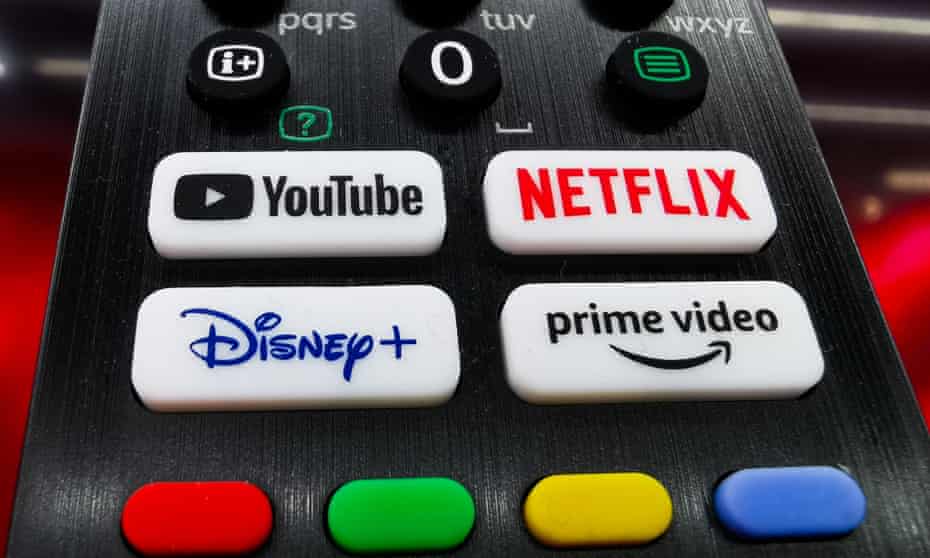Streaming’s dirty secret: how viewing Netflix top 10 creates vast quantity of CO2

Explosion in popularity of shows on Disney+ to YouTube raises question of impact on planet
Streaming has a dirty secret. The carbon footprint produced by fans watching a month of Netflix’s top 10 global TV hits is equivalent to driving a car a hefty distance beyond Saturn.
The world’s largest video-sharing site, YouTube, is responsible for emitting enough carbon dioxide annually to far surpass the equivalent greenhouse gas output of Glasgow, the Scottish city where world leaders will be gathering from Sunday at the Cop26 climate summit.
While much of the focus of campaigners falls on sectors that emit the most CO2 – such as aviation, automotive and food – the explosion in popularity of services from Disney+ to Netflix is raising the question of just how bad the streaming boom is for the planet.
Every activity in the chain required to stream video, from the use of huge datacentres and transmission over wifi and broadband to watching the content on a device, requires electricity – the majority of which is generated by emitting greenhouse gases.
“Strangely, environmental impact is a very young story in the streaming industry,” says Dom Robinson, the founder of Greening of Streaming, a fledgling body that aims to address the sector’s energy impact. “People talk about the bottlenecks in internet traffic caused by the growing demand for streaming and gaming services, but there is plenty of capacity, it is actually about the growing demand for power supply.”
Netflix has estimated that one hour of streaming by one user on its platform produces “well under” 100g of carbon dioxide equivalent (CO2e) – a unit of measure that indicates carbon footprint. More specifically, the Carbon Trust says the European average is 55g to 56g of CO2e for every hour of streaming video. That is equivalent to driving about 300 metres in a car.
Netflix recently gave a rare insight into its most popular global hits by total hours viewed, a metric it said last week it intended to publish more frequently. It reported that fans clocked up more than 6bn hours watching the top 10 shows – which included Squid Game, Stranger Things, Money Heist and Bridgerton – in the first 28 days after each show was released.
This equates to about 1.13bn miles (1.8bn km) of travel in a car based on the Carbon Trust estimate – the approximate equivalent of the current distance between Earth and Saturn.

As for YouTube, a report by researchers at Bristol University based on estimates of the streaming site’s usage in 2016, calculated that watching videos on the streaming site produced CO2e of more than 11m tonnes a year, similar to a city the size of Glasgow or Frankfurt. Given YouTube had 1.4 billion users that year, and now has more than 2.4 billion users globally, the company’s carbon footprint will be significantly bigger today.
Earlier this year, Netflix announced its aim to reach net zero greenhouse gas emissions by the end of 2022. The move follows similar climate-friendly aspirations announced in recent years by the large Silicon Valley companies such as Microsoft, Apple and Facebook. In the UK, companies including BT, the BBC and Sky have promised to hit net zero by 2030.
Robinson says such strategies must involve major reductions in emissions rather than just investing in green projects if they are to achieve carbon neutrality.
“Net zero has become the new carbon tax off-setting, to be able to say: ‘This is not my problem.’ There has to be a reduction engineered within businesses, not just an accounting trick, to make a difference,” he says.
“We have created Greening of Streaming because we know there is sufficient appetite within the streaming sector to make positive changes to reduce this environmental impact, and because the technology is there to make it achievable.”
One thorny issue is whether the emissions run up by consumers watching the shows should be factored in. Netflix’s net zero plan is only based on the carbon footprint of its corporate operations and the making of films and TV shows.
In a blog explaining how it estimates emissions, Netflix said internet service providers and device manufacturers, such as TV, iPad and mobile phone makers, should “ideally account for those emissions themselves”.
“The calculation of carbon footprint should include user devices as that is where the digital services are being consumed,” says Daniel Schien, senior lecturer in computer science at the University of Bristol, whose carbon modelling tool has been used by Netflix, the BBC and the Carbon Trust among others. “Exclusion of that part of the footprint will undermine the ability to manage and reduce it.”
The growth in internet traffic has been stratospheric in the last few years, with as much as 80% of the data capacity taken up by the popularity of the bandwidth-heavy services of a handful of companies such as Netflix, YouTube, Facebook, Activision Blizzard, which makes Call of Duty, and Epic Games, the company behind Fortnite.
However, Schien cautions that the inexorable growth of 50% annually on average in demand for capacity does not directly correlate to the same rate of increase in carbon emissions. He cites factors such as 20%-plus annual improvement in efficiency in networks and datacentres that offsets some of the increase.
“The majority of the carbon-per-hour video streaming produces is in the home,” he says. “The big footprint is TVs, which are getting bigger. And remember those TV emissions take place whether you are watching a regular broadcast or streaming, and broadcast TV is still far more popular than streaming.”
The UK media regulator Ofcom estimated that total video consumption rose from four hours 50 minutes a day to five hours 40 minutes last year as the nation was stuck at home, with the viewing of linear TV and recorded shows accounting for almost 60% of that.
Time spent on subscription streaming services such as Netflix climbed from 30 minutes to 50 minutes, still a small proportion of overall emissions-heavy screen time.
Schien also points out that in terms of contributing to overall UK greenhouse gas emissions, the streaming and TV industry remains a minnow. Just microwaving a bag of popcorn for four minutes produces about 30% the emissions of watching an hour of streamed content.
“Every little helps but the carbon intensity of streaming as a proportion of the economy is very small,” he says. “Heating, mobility and food are the things we think most about.
“I’m not saying we don’t need to care about it, but something as innocent as muesli, with milk, has a higher carbon footprint than one hour streaming.”
